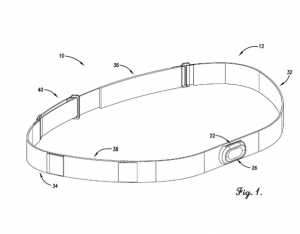While exercise monitoring devices are made to deal with moisture and sweat, have you ever wondered how professional swimmers monitor their exercise while submerged? During the presentation on elevation masks in class I became intrigued about how complex it would be to monitor exercise in the water. This thought led me to the discovery of a swimming heart rate monitor in the form of a chest strap. Waterproof watches and dive computers that can also track heart rates exist on the market, however chest straps are known to provide a more accurate reading due to the proximity to the heart. But how could this design stay on, stay dry, and maintain accuracy? Let’s look into it.
Patent Title: Swimming Heart Rate Monitor
Patent Number: US20140336493 A1
Patent Filing Date: May 8, 2014
Patent Issue Date: Nov 13, 2014
Length for patent to issue: ~6 months
Inventors: Christopher J. Kulach, Timothy Vandermeiden, James K. Rooney, Rogelio A. Rivas, Phillip J.C. Spanswick
Assignee: Garmin Switzerland Gmbh
U.S. Classification: 600/390 (Belt or strap)
How Many Claims: 20

Figure 1. Front perspective view of swimming heart monitor containing electronics module at point 22 and length adjusting mechanisms at point 40.
The device shown in Figure 1 is comprised of two electrodes, two electrical connectors, an electronics module, and a water sealing feature. The adjustable strap, to be worn on the upper torso, is specifically designed to maintain function in chlorinated water, salt water, throughout intense body movement at high pressures. The electronic module processes electrical activity generated by the heart beat which is picked up by the electrodes. The electrical connectors on the external surface of the strap link the module to the electrodes. The connectors are enclosed by a water sealing feature, and attached to the removable electronic module which is in its own watertight housing. This module can be removed from the water-proof strap and used with other straps, in or out of water. This provides users with flexibility at a low cost. The user can monitor the heart rate in real time or upon completion of the exercise.

Figure 2. View of the module coupler and housing which are located on the external surface of the strap.
The strap itself, in length, is one third fabric elastic material and two thirds inelastic material, such as polyester, and is adjustable in length. The inelastic section is coated with a material, such as silicone, to increase the coefficient of static friction and prevent water flow between the skin and strap. The device creates a barrier from water, which would attenuate the amplitude of the heart signal, using two O-rings axially positioned on a post of the electrical connector. The electronics module is held in place by the coupler in Figure 2, also sealed by a water-proof housing. Electrically conductive materials, such as conductive thermoplastic polyurethane (CTPU) or conductive silicone is used for the electrodes in order to maintain flexibility so contact with the skin remains constant. The module is to be placed around the sternum, with each electrode on either side. More electrodes could also be added to measure galvanic skin response, which tells the user information about hydration levels. The electronic connectors consist of a cylindrical post that attaches to an interlocking mechanism on the electronics module. The connectors also contain a first and second contact, which include an electrically conductive pin made from steel or copper that connects to the electronic component of the module. To combat skin impedance, filtering techniques such as the Lease-Means Square Algorithm are used to calculate the heart rate. The electronic module contains a battery, signal amplifiers, processing elements, memory elements, transmitters, and antennas that allow the data to be communicated in several ways. Certain models may also contain inertial sensors such as accelerometers or gyroscopes, so the device can be personalized to the user’s needs.
This patent referred to wrist monitors, headbands, and belts with similar capabilities, some for aquatic use and some for land. It is ideal out of this group of ideas because of its proximity to the heart which typically results in more accurate signals. Compared to other chest straps, it is ideal for aquatic environments because of the proportions of elasticity of the strap. This provides a snugness that is designed not to fold on itself or slip away from the heart when wet, and the materials for the electrodes are designed similarly. I found it particularly impressive that the device is multifunctional and adaptable beyond heart rate monitoring.
Physical therapy clinics would be a great target audience because of this, as they could buy a few different models and adapt per patient as necessary, saving them both money and space. This technology is also useful for competitive swimmers and triathletes. For those training, it allows them to reach their specific training goals, whether they want to hit the recovery, aerobic, or lactate threshold training zone. For those in rehab, where a physical therapist might want to ensure they are not surpassing a certain heart rate, this device would be ideal and potentially more accurate than a heart rate monitor worn on the risk. My question about underwater exercise monitoring was answered by this patent as well as the other related products that are being developed, and it’s interesting to think about what this kind of technology might lead to in the future of rehab and water-sports.

